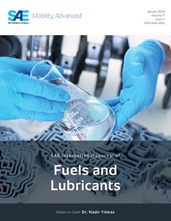Modeling of the Soot Accumulation in DPF Under Typical Vehicle Operating Conditions
- Event
- Content
- The pressure losses across the different parts of a regenerative Diesel Particulate Filter (DPF) have been modeled and compared with the measured pressure loss and with the measured changes in the instantaneous weight of the DPF of a commercial automotive diesel engine. The comparisons were made in three operating conditions selected among those included in the transient cycle established in the European Emission Directive. The first one is a low-load mode, with high soot emissions and therefore with high contribution to the DPF charge. The second one is a medium-load mode, in which the balance of soot charge versus spontaneous soot regeneration leads to a slow DPF charging, the temperature at the exhaust manifold being high enough to permit active regeneration. The third one is a high-load mode, in which the spontaneous regeneration leads to a net DPF discharge, the active regeneration becoming useless. The model proposed uses computational fluid dynamics (Fluent®) for validating the hypothesis of homogeneous pressure distribution in the conical inlet and along the filter channels. Once validated, a simplified model is used to estimate the effect of the morphology of soot agglomerates (porosity, specific surface, apparent density, fractal dimension, etc.) and of the soot oxidation reactivity on the DPF charging process. A precise estimation of the actual filter charge from the on-line measurement of the pressure difference up and downstream the DPF (considering the characteristics of the fuel used) would permit to optimize the engine regeneration strategies to be implemented in the Electronic Control Unit (ECU).
- Pages
- 11
- Citation
- Lapuerta, M., Oliva, F., and Martínez-Martínez, S., "Modeling of the Soot Accumulation in DPF Under Typical Vehicle Operating Conditions," SAE Int. J. Fuels Lubr. 3(2):532-542, 2010, https://doi.org/10.4271/2010-01-2097.
